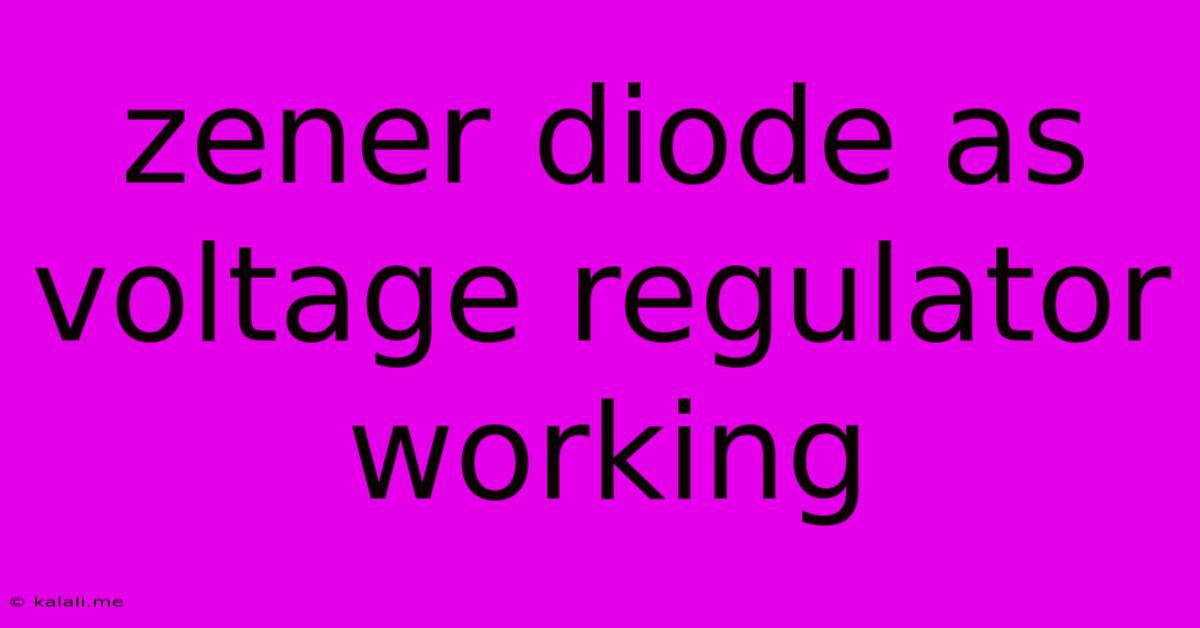Zener Diode As Voltage Regulator Working
Kalali
May 21, 2025 · 3 min read

Table of Contents
Zener Diode as a Voltage Regulator: A Deep Dive
Meta Description: Learn how a Zener diode works as a voltage regulator. This comprehensive guide explains its operation, applications, advantages, and limitations, providing a solid understanding of this crucial component in electronics.
The Zener diode, a special type of diode, finds its niche as a simple yet effective voltage regulator. Unlike standard diodes that conduct current only when forward-biased, a Zener diode is designed to operate in the reverse breakdown region, maintaining a relatively constant voltage across its terminals even when the current varies. This characteristic makes it an invaluable component in various electronic circuits requiring stable voltage supply.
Understanding Zener Diode Operation
At the heart of the Zener diode's voltage regulation capability lies its unique reverse bias behavior. When a reverse voltage is applied across a standard diode, a tiny leakage current flows. However, when the reverse voltage exceeds a specific threshold, called the Zener voltage (Vz), the diode enters the breakdown region. In this region, a significant increase in reverse current occurs while the voltage across the diode remains relatively constant at Vz. This near-constant voltage, despite changes in current, is the basis of its voltage regulation function.
The Zener effect, responsible for this breakdown, is a combination of two mechanisms: avalanche breakdown and Zener breakdown. Avalanche breakdown occurs at higher Zener voltages and involves the generation of electron-hole pairs due to high electric field strength. Zener breakdown, prevalent at lower voltages, is due to quantum mechanical tunneling of electrons across the depletion region. While both contribute to the reverse breakdown, the term "Zener diode" is used broadly for both mechanisms.
Zener Diode as a Voltage Regulator Circuit
A simple Zener diode voltage regulator circuit typically consists of a Zener diode connected in reverse bias across the load, along with a series resistor (Rs). The input voltage (Vin) is applied across the series combination of Rs and the Zener diode. The resistor limits the current flowing through the circuit, preventing damage to the Zener diode.
Here's how it works:
- If Vin is greater than Vz, the Zener diode conducts, maintaining a constant voltage Vz across the load. Any fluctuations in Vin are absorbed by the Zener diode, keeping the output voltage stable.
- The current flowing through the Zener diode (Iz) is given by: Iz = (Vin - Vz) / Rs
- The current flowing through the load (IL) is determined by the load resistance.
Choosing the appropriate Zener diode and resistor is crucial:
- Zener voltage (Vz): This should be chosen to match the desired regulated voltage.
- Zener power rating: This should be chosen to accommodate the maximum power dissipation (Pz = Vz * Iz).
- Series resistor (Rs): This should be chosen to limit the current through the Zener diode to a safe value, and provide enough current for the load.
Advantages of using Zener Diodes as Voltage Regulators
- Simplicity: Zener diode regulators are simple to design and implement, requiring minimal components.
- Cost-effectiveness: Zener diodes are relatively inexpensive.
- Low noise: They produce low noise, making them suitable for sensitive applications.
Limitations of Zener Diode Regulators
- Power dissipation: Zener diodes dissipate power as heat, limiting their effectiveness at high currents. A heat sink might be needed for higher power applications.
- Efficiency: They are not very efficient, as a significant portion of the input power is dissipated as heat.
- Voltage regulation range: The effectiveness of the regulation is limited to a specific range of input voltage and load currents.
- Temperature sensitivity: The Zener voltage varies with temperature, requiring temperature compensation for critical applications.
Conclusion
The Zener diode, despite its limitations, serves as a simple and effective solution for voltage regulation in various applications where low power and simplicity are prioritized. Understanding its operating principles and limitations allows engineers to effectively utilize this valuable component in circuit design. For higher power applications or more precise voltage regulation, more complex regulator circuits are typically required.
Latest Posts
Latest Posts
-
How Often Clean A Fish Tank
May 21, 2025
-
Flame On Gas Stove Is Yellow
May 21, 2025
-
Is White Spirit The Same As Surgical Spirit
May 21, 2025
-
Rust On Clothes How To Get It Out
May 21, 2025
-
What Is A Utility Knife Used For
May 21, 2025
Related Post
Thank you for visiting our website which covers about Zener Diode As Voltage Regulator Working . We hope the information provided has been useful to you. Feel free to contact us if you have any questions or need further assistance. See you next time and don't miss to bookmark.